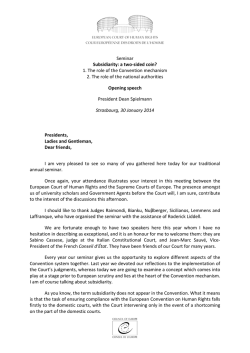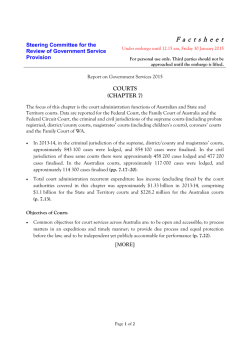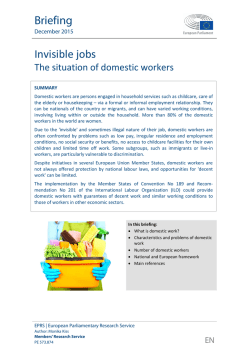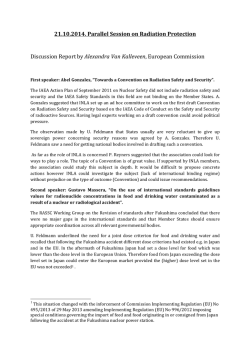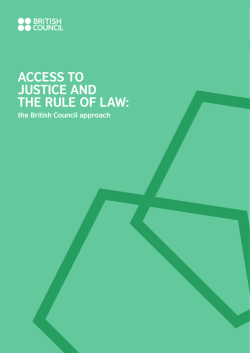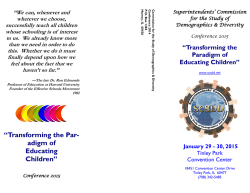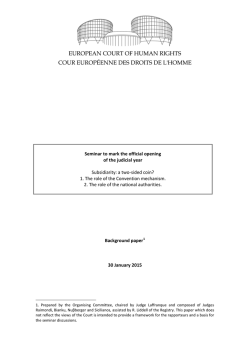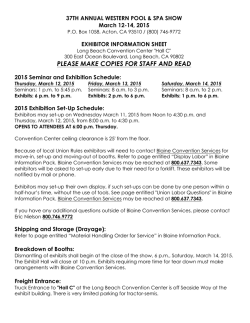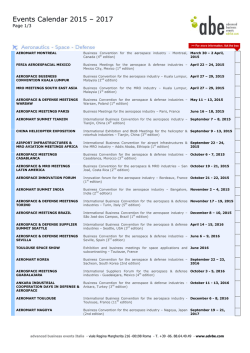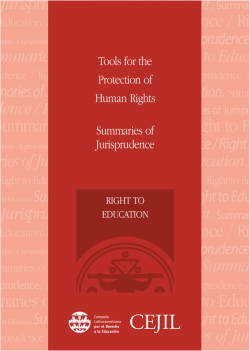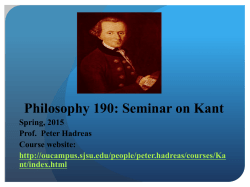
Speech by the President - Solemn hearing
Solemn hearing for the opening of the judicial year of the European Court of Human Rights Opening speech President Dean Spielmann Strasbourg, 30 January 2015 Presidents of Constitutional Courts and Supreme Courts, President of the Parliamentary Assembly, Secretary General of the Council of Europe, Excellencies, Ladies and gentlemen, I would like to thank you personally and on behalf of all my colleagues for kindly attending this solemn hearing for the opening of the judicial year of the European Court of Human Rights. Your presence here bears witness to your respect and esteem for our Court and we are very grateful for your support. Today’s hearing is a particularly momentous occasion for me. It is the last time I will be addressing you in these circumstances. It is still too soon to draw final conclusions and the challenges that lie ahead in 2015 are considerable, but let us, nevertheless, as we embark upon this new judicial year, take stock of what we have achieved. Our achievements are impressive. In 2014 the Court gained further ground in its control over the flow of cases submitted to it. The exceptionally positive trend that I previously reported for 2012 and 2013 has been confirmed over the past year. In total, in 2014, the Court ruled in over 86,000 cases. The number of cases disposed of by a judgment remains high: 2,388, compared to 3,661 the previous year. At the end of 2013 there were some 100,000 applications pending. That figure was down by 30% at the end of 2014, standing at 69,900. This is a far cry from the astronomical figure of 160,000 pending applications in September 2011, which gave cause for concern about the very survival of the system. The single-judge procedure, stemming from the implementation of Protocol No. 14, the increasingly frequent recourse to pilot judgments, but above all the modernisation and streamlining of our working methods, lie at the heart of those achievements. We have come a long way but cannot stop there. I firmly believe that the model we have been using for singlejudge cases has not exhausted its full potential. Applying the same tried and tested methods, we will now have to tackle the repetitive cases. In dealing with such cases it is important to bear in mind, where the complaint is well-founded, that the applicant should be able to obtain Solemn hearing – 30 January 2015 redress as quickly as possible. This should be possible with the methods we are currently introducing. Ultimately – and I hope this will be the case in the near future – our Court should no longer be burdened by repetitive cases. This will enable us to devote all our efforts to the most problematic and serious matters. While my observations on the Court’s activity have been particularly positive, it must nevertheless be said that the Court cannot act alone. Even if we introduced the most sophisticated resolution mechanisms, that would not suffice to stem the flow of cases coming before the Court. For it is incumbent upon the States themselves to be proactive in resolving structural and endemic problems. The question of repetitive cases is of course related to that of the execution of judgments. One cannot overestimate the importance of the Council of Europe’s Committee of Ministers with its task of supervising the execution of the Court’s judgments. It is not only the Court’s credibility that is affected by failure to execute judgments, it is also that of the Committee of Ministers. This goes to the heart of the principle of shared responsibility between the Court and the States. And that is why I commend the initiative of Belgium to organise, in connection with its chairmanship, on 26 and 27 March in Brussels, a major intergovernmental conference which will precisely address this question. I hope that all the stakeholders in the system will take part in this event, at the highest level. Among those stakeholders are the national parliaments, whose role is of particular importance. They can intervene in two ways: upstream, by scrutinising the compatibility of bills before parliament with the European Convention on Human Rights and our Court’s case-law; and downstream, by ensuring that any legislative amendments rendered necessary by our judgments are adopted. It is quite rare for us to be able to establish direct contact with national parliaments and, in that connection, my speech before the Swiss Federal Parliament, on 9 December, remains an exceptional event. However, I would make two positive observations: firstly, that an increasing number of national parliaments have set up commissions to ensure the proper execution of the Court’s judgments; secondly, that the Parliamentary Assembly of the Council of Europe constitutes a crucial and effective relay between the Court and the national parliaments. Allow me to pay tribute to the unrelenting action of my compatriot and friend, Anne Brasseur, President of the Assembly, who is an ardent advocate of an increased role for the Parliamentary Assembly in the execution of our judgments, and who has made a considerable contribution to the strengthening of its relations with the Court. The Parliamentary Assembly has, more than ever, been playing the role of amplifier of our judgments. We are grateful for its support. Of course, it is mainly with the other national and international courts that we have been pursuing our dialogue in 2014. I will not enumerate here all the meetings that have been held. However, I would like to mention the visit of a few days that we received from our sister institution on the American continent, the Inter-American Court of Human Rights. I am pleased to note the ever-closer relationship that has been built up, over the years, between our two courts. In 2015 we will receive a delegation from the International Court of Justice. These meetings reflect our idea of an international court that is open and receptive to other courts. This is surely the best antidote to avoid becoming stuck in one’s ways ... As regards national courts, I have already had many opportunities to express the importance that I attach to Protocol No. 16, the protocol of dialogue with the highest courts of our member States. To date, sixteen States have already signed it. I hope that 2015 will be the - 2/6 - Solemn hearing – 30 January 2015 year of the ten ratifications which are required for its entry into force. To foster dialogue with supreme courts is at the forefront of my concerns. That is why I intend to set up, in 2015, an information exchange network, which will enable all supreme courts to have a point of contact within our Court, through our Jurisconsult, who will be able to provide them with information about our case-law as and when they need it. This will not be a one-sided dialogue and we will also have the benefit of the various resources made available by their respective research departments. So even before Protocol No. 16 enters into force, this network of shared research will facilitate the application of the European Convention on Human Rights by national supreme courts. As is usual on this occasion, mention must be made of the leading cases that have been decided over the past year. What are the most noteworthy cases from 2014? First of all, and by way of introduction, I am sure you recall that last year I expressed, on this very occasion, my concern about the events taking place in Ukraine. This region of Europe has not been spared over the past months and this has had a direct impact on the activity of our Court, which is currently examining three inter-State applications lodged by Ukraine against the Russian Federation, as well as a very large number of individual applications against either State. The current crisis on our European continent shows the extent to which, in such circumstances, the need for strong European justice is crucial. As regards, more specifically, the cases heard in 2014, I would observe that increasingly sensitive matters have been coming before our Court. Applicants and States have expected us to take a position on infinitely complex matters. To mention only a few examples, one was the question of State responsibility for sexual abuse perpetrated in State-run schools in Ireland (the case of O’Keeffe, 28 January 2014); another was the French ban on the concealment of one’s face in public, in the S.A.S. case of 1 July 2014; there was also the question of the legal effects of a change of gender on pre-existing marriages, in Hämäläinen v. Finland (16 July 2014). I could cite many more examples, given the considerable variety of questions put to our Court. This is proof of the extraordinarily living nature of the European Convention on Human Rights. With there being no consensus on some of these issues, and with certain cases concerning totally new questions of society, our Court bears a particularly heavy responsibility, since, as you know, our findings will be scrutinised not only by the parties to the dispute, but also by the supreme courts of the member States, by the media and by public opinion, sometimes far away from the country concerned by the judgment. States tend to accuse us of activism when we find against them, while applicants reproach us for showing restraint if we do not find a violation. To provide the best possible response, our Court necessarily treads a narrow path. We face a constant challenge as regards the acceptability of our decisions. This question is all the more sensitive as our legitimacy is conferred on us by the States that we find against, and our position is therefore far from easy. We do not follow a particular judicial strategy, but it goes without saying that we do think about how our judgments will be received. However, such considerations are circumscribed by our obligation to ensure compliance with the European Convention on Human Rights. The rhythm imposed by our Court is not necessarily the same as that of the member States. Sometimes we go further and advance more quickly. But not always and not systematically. It even happens – and this is increasingly the case –that, in applying the Convention, domestic courts are already ahead of us. Such superimposing of different rhythms which play out simultaneously and independently of each other can be compared to the use of polyrhythms, - 3/6 - Solemn hearing – 30 January 2015 well known to musicians, and of which a celebrated example can be found in the “Sacrificial Dance” from Igor Stravinski’s “The Rite of Spring”. The rhythmic structure is the starting point in the “The Rite of Spring”, not so much because of its predominance over the other musical parameters, but because it organises the rest. One hundred or so years ago Stravinski thus invented a new tempo. In the European Court of Human Rights and in the national courts, we each have our own rhythms that we strive to play together, with our living instrument, the Convention. A recent example, in a French case, illustrates a situation in which our Court was asked to settle a new question and to impose its tempo. The question was a highly sensitive one, because it related to a procreation technique not hitherto addressed, namely, recourse to surrogacy arrangements, which is prohibited in France. Our Court did not find a violation of the Convention on account of the ban on surrogacy arrangements in France. In the cases in question, which have been much commented upon, the Court focused on the interests of the child, and the violation of the Convention that it then found was based exclusively on its consideration of the right of children to respect for their private life, as everyone must be able to establish the substance of his or her identity, and in particular the legal parent-child relationship with a genetic parent. Such cases show that the Court seeks first and foremost to ensure compliance with the Convention without interfering in the national debate. In choosing not to request the referral of that case to the Grand Chamber, the French Government have proved that the decision adopted was acceptable. The other case that I would like to point out illustrates once again the prudence of our approach in the most sensitive matters: the case of Tarakhel v. Switzerland, concerning the return of a family of asylum-seekers to Italy. The question of migratory flows has arisen in many of our States. The solutions that we seek to establish in response to complex issues must be in keeping with our principles, particularly humanitarian considerations. In Tarakhel the Court thus took the view that there would be a violation of the Convention if the Swiss authorities returned the applicants to Italy without having first obtained individual guarantees that they would be taken charge of in a manner adapted to the age of the children and that the family would be kept together. The Tarakhel case is very different from cases relating to surrogacy arrangements or from those concerning children who were sexually abused in religious schools in Ireland. However, in all these cases the specific situation of the children has been taken into account and has guided the Court in its decision. These examples undoubtedly reflect the duty which the Court constantly endeavours to fulfil, namely to protect the weakest and most vulnerable. It is also for that reason that the Court has been known for several years now by the expression “The Conscience of Europe”. This is the title of a book about our Court with which many of you are familiar. We were thus particularly proud to have heard this expression used by His Holiness Pope Francis during his speech to the Council of Europe on 25 November. It was seen as an encouragement to pursue our mission, serving the cause of human rights protection in Europe. With that in mind, I am sure you will not be surprised, as I draw to a close, if I refer to the opinion given on 18 December by the Court of Justice of the European Union on the proposed accession of the European Union to the Convention. Let us be clear: the - 4/6 - Solemn hearing – 30 January 2015 disappointment that we felt on reading this negative opinion mirrored the hopes that we had placed in it – hopes shared widely throughout Europe. In deciding that the Union would accede to the European Convention on Human Rights, the drafters of the Lisbon Treaty clearly sought to complete the European legal area of human rights; their wish was that the acts of EU institutions would become subject to the same external scrutiny by the Strasbourg Court as the acts of the States. They wanted above all to ensure that a single and homogenous interpretation of human rights would prevail over the entire European continent, thereby securing a common minimum level of protection. The opinion of the Court of Justice does not render that plan obsolete; it does not deprive it of its pertinence. The Union’s accession to the Convention is above all a political project and it will be for the European Union and its member States, in due course, to provide the response that is called for by the Court of Justice’s opinion. For my part, the important thing is to ensure that there is no legal vacuum in human rights protection on the Convention’s territory, whether the violation can be imputed to a State or to a supranational institution. Our Court will thus continue to assess whether State acts, whatever their origin, are compliant with the Convention, while the States are and will remain responsible for fulfilling their Convention obligations. The essential thing, in the end, is not to have a hierarchical conception of systems that would be in conflict with each other. No, the key is to ensure that the guarantee of fundamental rights is coherent throughout Europe. For, let us not forget, if there were to be no external scrutiny, the victims would first and foremost be the citizens of the Union. Ladies and Gentlemen, I would like to have ended my speech at this juncture, but there is something else I am compelled to mention. What I have to say concerns the events earlier this month, in France, our Court’s host country, when two of our fundamental values came under attack: the right to life and the right to freedom of expression. For over 50 years now our Court has been defending freedom of expression. A freedom that is applicable to ideas that “offend, shock or disturb the State or any sector of the population. Such are the demands of that pluralism, tolerance and broadmindedness without which there is no ‘democratic society’” – to quote the wording that dates back to the Handyside judgment. Our Court even invented an expression that is now celebrated worldwide: “journalists are the watchdogs of democracy”. It was natural that in such circumstances the Court should join in the movement which proliferated, throughout the world, to show solidarity with the victims of the attacks: among them journalists, policemen, and citizens who were killed because they were Jews. I am convinced that the States, in their response to those acts, whether at a national or an international level, will ensure that human rights are preserved. To quote Nicolas Hervieu, one of the shrewdest observers of our case-law, writing a few days ago: “To pursue the fight against terrorism while upholding fundamental rights is not a luxury, but a condition of effectiveness and a compelling necessity. Any renouncement of our democratic values would only lead to defeat. And the terrorists would be the winners”. - 5/6 - Solemn hearing – 30 January 2015 Mr Francisco Pérez de los Cobos, President of the Constitutional Court of the Kingdom of Spain You come from a country which has suffered heavily as a result of terrorism, and the Constitutional Court of which you are President has played a key role in Spain’s transition to a democracy. I have mentioned here this evening the acceptability of our judgments. Among the recent examples of the perfect reception of a leading decision, the exemplary manner in which Spain implemented our judgment in the Del Río Prada case is to be commended. I welcomed that response on this very occasion last year. Your presence here is a great honour for us and it is with pleasure that I now kindly invite you to take the floor. - 6/6 -
© Copyright 2025
